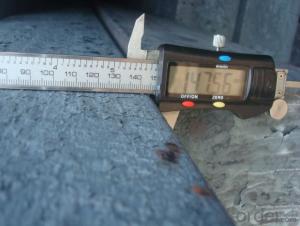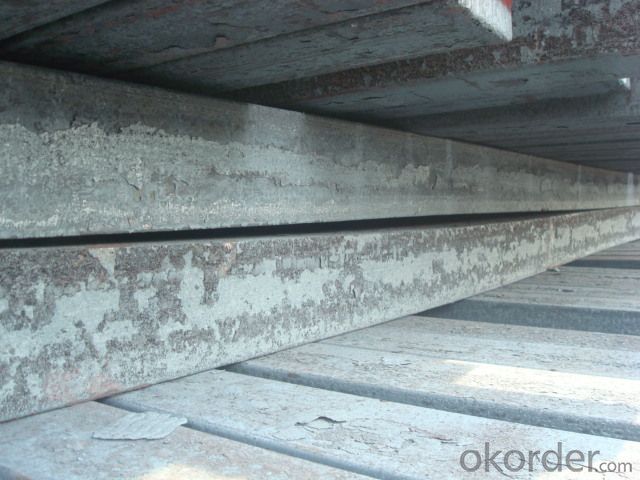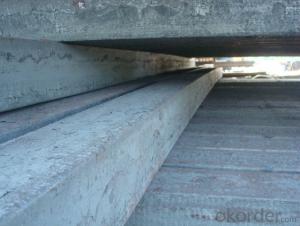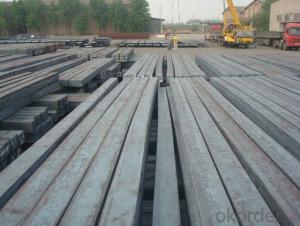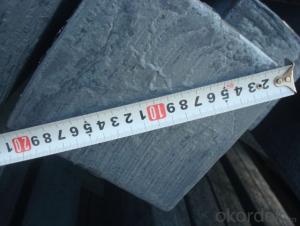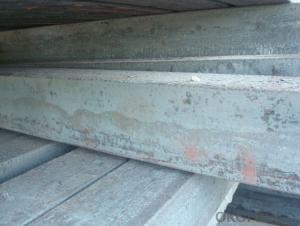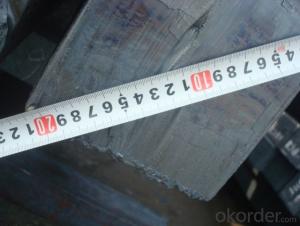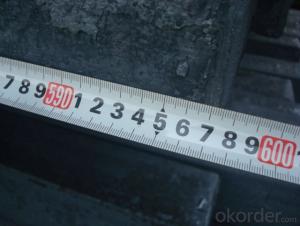Continue Casting Steel Bloom by Blast Furnace Manufactured by Big Steel Mill
- Loading Port:
- Tianjin
- Payment Terms:
- TT OR LC
- Min Order Qty:
- 1000 m.t.
- Supply Capability:
- 100000 m.t./month
OKorder Service Pledge
OKorder Financial Service
You Might Also Like
Continue Casting Steel Bloom by Blast Furnace Manufactured by Big Steel Mill
1.Structure of Continue Casting Steel Bloom by Blast Furnace Manufactured by Big Steel Mill
Continue Casting Steel Bloom by Blast Furnace Manufactured by Big Steel Mill is the raw material of all kinds of steel mill. Billet section of square, round, flat, rectangular and abnormity, etc Several, mainly related to shape of rolled products. Simple rolled section steel, choose cross section of square billet or rectangular billet. rolling The sector products such as flat steel, Angle steel, select the rectangular billet or slab. Had better profiled billet when production beams, channels, and in rolling process Lines and improve the yield. The raw material of round billet is the production of seamless tube.
2.Main Features of Continue Casting Steel Bloom by Blast Furnace Manufactured by Big Steel Mill.
Steel Bloom Manufactured by Blast Furnace section size should meet the requirements of rolling deformation and finished product quality, but also roll strength and biting condition of restrictions. General steel Billet section height H. And the roll diameter D The ratio of the ( namely H/D) Should be less than or equal to zero 0.5 . Length of steel billet by finishing temperature, Rolling time and the length of the product Or times ruler. When heated too long accident prone to bump the furnace wall of steel, too short, furnace bottom utilization rate is not high, influence the heating furnace production. For the production Choose a variety of steel and steel billet, should consider the affinities of billet, as far as possible in order to improve the productivity of the roughing mill, simplify the stock management of workshop.
3. Continue Casting Steel Bloom by Blast Furnace Manufactured by Big Steel Mill Images
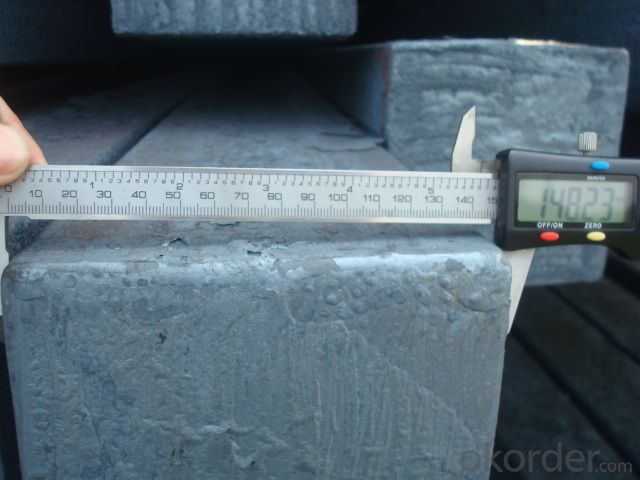
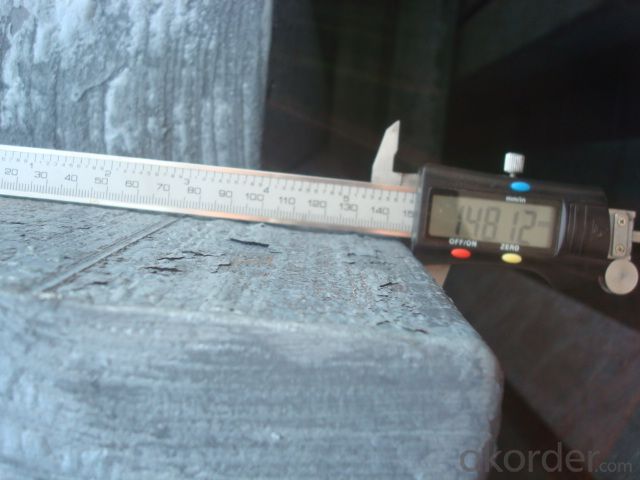
4. Continue Casting Steel Bloom by Blast Furnace Manufactured by Big Steel Mill Specification
Continue Casting Steel Bloom by Blast Furnace Manufactured by Big Steel Mill rolled steel, after processing can be used for mechanical parts, forging parts, processing all kinds of steel, steel Q345B channel steel, wire rod is the role of the billet. Steel billet is used in the production of semi-finished products, generally cannot be used directly for the society. Steel billets and steel are strictly divided into standard, cannot decide to whether the business enterprise of the final product, and according to unified standards to perform the whole society. Typically, billet and the steel is relatively easy to distinguish, but for some steel billet, and have the same specification and same steel purposes (such as rolling tube billet), whether can be used for other industries, whether through steel processing process, whether through a finished product rolling mill processing to distinguish
Material standard The editor Range of thickness: 150-240 - mm + / - 5 mm width range: 880-1530 - mm + / - 20 mm Length: 3700-10000 - mm + / - 500 - mm Cross-sectional size: 64 * 64; 82 * 82; 98 * 98; 124 * 124; 120 * 150; 152 * 164; 152 * 170 mm Length: 9000 mm Section of tolerance: billet: 1.0 + / - 2.0-1.0 + / - 1.0 mm slab: width: + / - 2.0 mm thickness: + / - 3.0 mm The length tolerance: + / - 200 mm Section diagonal tolerance: 3.5-8.0 MM Billet section size protrusions requirements: < 1242 mm, do not allow; > = 1242 mm, < = 2 mm 1242 mm, < = 3 mm Beheading (shear) extension deformation: < 1242 mm billet: no control; The slab: < = 15 mm Surface tilt: no more than billet section 0.1 Bending: every 1 m length is not more than 10 mm The distortion: length < = 5 m, < = 11. ; The length of the < = 7.5 M, < = 5. Material % 3 sp/PS chemical composition: C Mn Si S P
5.FAQ of Continue Casting Steel Bloom by Blast Furnace Manufactured by Big Steel Mill
We have organized several common questions for our clients,may help you sincerely:
①How about your company?
A world class manufacturer & supplier of castings forging in carbon steel and alloy steel,is one of the large-scale professional investment casting production bases in China,consisting of both casting foundry forging and machining factory. Annually more than 8000 tons Precision casting and forging parts are exported to markets in Europe,America and Japan. OEM casting and forging service available according to customer’s requirements.
②How to guarantee the quality of the products?
We have established the international advanced quality management system,every link from raw material to final product we have strict quality test;We resolutely put an end to unqualified products flowing into the market. At the same time, we will provide necessary follow-up service assurance.
③How is the standard of the steel billet products?
Continuous casting billet of carbon-steel chemical composition to perform "carbon structural steel"GB700-88.standard;Appearance quality inspection Implementing the continuous casting billet and the rectangular billet,YB2011-83Standard.
- Q: How are steel billets cut into smaller pieces?
- Steel billets can be reduced in size through the process of sawing or shearing. Different techniques are employed based on the desired size and accuracy of the cuts. A commonly used method involves the utilization of specially designed saw blades, such as circular or band saws, specifically created for cutting metal. Depending on the scale of the operation, these saws can be operated manually or automated. To prevent movement, the billets are securely clamped, and the saw blade is guided along the marked cutting line, gradually slicing through the steel to create smaller pieces. Another approach is shearing, which involves the use of a shear machine that applies intense force to cut through the billet. This method is typically employed for thicker billets or when precise cuts are not required. The shear machine includes a fixed blade and a moving blade that come together to separate the billet along the desired cutting line. Furthermore, advanced technologies like laser cutting or plasma cutting can also be utilized for cutting steel billets into smaller pieces. These methods make use of high-powered lasers or plasma jets to melt or vaporize the material along the cutting line, resulting in a clean and precise cut. Ultimately, the choice of cutting method depends on factors such as billet thickness, desired cutting precision, and production capacity. Regardless of the method chosen, safety precautions are always taken to ensure the well-being of operators and to maintain the quality of the cut steel pieces.
- Q: What is the role of steel billets in the construction of bridges and tunnels?
- Steel billets play a crucial role in the construction of bridges and tunnels. These billets are semi-finished steel products that are further processed to create various structural components used in the construction industry. In the context of bridges, steel billets are utilized to manufacture steel beams, girders, and columns, which form the skeleton of the bridge. These components provide the necessary strength and stability to support the weight of the bridge and the traffic it carries. Steel billets are chosen due to their high strength-to-weight ratio, making them ideal for constructing long-span and heavy-load bridges. Similarly, in tunnel construction, steel billets are utilized to create reinforcement bars or rebars. These rebars are embedded within the concrete walls and floors of tunnels, providing additional strength and support to withstand the immense pressure and weight of the surrounding soil or rock. Additionally, steel billets are also used to fabricate tunnel linings, which protect the tunnel walls from erosion, corrosion, and other forms of deterioration. The use of steel billets in bridge and tunnel construction offers several advantages. Firstly, steel is a highly durable and resilient material, capable of withstanding extreme forces, temperature variations, and environmental conditions. This durability ensures the longevity and structural integrity of bridges and tunnels, reducing maintenance and repair costs over time. Secondly, steel billets can be easily shaped, molded, and welded into various complex shapes and sizes, allowing for flexibility in design and construction. This versatility enables engineers to create innovative and efficient bridge and tunnel structures, accommodating different architectural and engineering requirements. Lastly, steel billets are known for their excellent load-bearing capacity, making them suitable for high-traffic areas such as bridges and tunnels. They can withstand heavy loads and distribute the weight evenly, minimizing the risk of structural failure or collapse. In conclusion, steel billets play a vital role in the construction of bridges and tunnels by providing the necessary strength, durability, and flexibility. They form the backbone of these structures, ensuring their stability, longevity, and ability to withstand various environmental and operational challenges.
- Q: What is the average density of a steel billet?
- The density of a steel billet can differ based on its specific grade and composition. On average, a steel billet has a density ranging from approximately 7,800 to 8,050 kilograms per cubic meter (kg/m³). This density is higher than that of numerous other materials, rendering steel a dense and weighty substance. When determining the weight, volume, and overall structural properties of a steel billet, its density plays a vital role.
- Q: What are the properties of alloy steel billets?
- Alloy steel billets are highly sought after in various industries due to their numerous desirable properties. Chief among these is their exceptional strength and toughness, which is attributed to the presence of alloying elements like chromium, nickel, molybdenum, and vanadium. This heightened strength enables the billets to withstand heavy loads and high temperatures, making them ideal for applications that demand resistance to wear and tear. Furthermore, alloy steel billets possess excellent corrosion resistance, rendering them perfect for use in harsh environments or exposure to chemicals. This resistance to corrosion not only extends the lifespan of the billets but also ensures their durability over time. Moreover, alloy steel billets exhibit good machinability, allowing them to be easily shaped, formed, and fabricated into various products or components. This quality facilitates the creation of intricate and complex designs, making them versatile for use in automotive, construction, and manufacturing industries. Another noteworthy property of alloy steel billets is their ability to undergo heat treatment. This process enables the adjustment of their mechanical properties, such as hardness and ductility, to meet specific requirements. Heat treatment enhances the strength and toughness of the billets, making them even more suitable for heavy-duty applications. Lastly, alloy steel billets possess excellent weldability, enabling them to be easily joined together through various welding techniques. This characteristic adds to their versatility and allows for the construction of larger structures or the fabrication of complex assemblies. In conclusion, the properties of alloy steel billets, including strength, corrosion resistance, machinability, heat treatability, and weldability, make them extremely valuable in industries where high performance and durability are crucial.
- Q: What are the different types of steel billet machining processes?
- There are several types of steel billet machining processes, including turning, milling, drilling, and grinding. Each of these processes involves different techniques and tools to shape and refine the steel billet into the desired form or component.
- Q: How are steel billets used in the production of automotive steering systems?
- Steel billets are an essential component in the production of automotive steering systems. These billets are typically made from high-quality steel and serve as the raw material for manufacturing various steering system components, such as shafts, gears, and housings. To begin the production process, steel billets are first heated and softened to make them more malleable. This allows the billets to be easily shaped and formed into the desired steering system components through processes like forging, rolling, or casting. The specific method used depends on the complexity and function of the component being produced. Once the desired shape is achieved, the steel billets are further processed to enhance their strength and durability. This may involve heat treatment techniques like quenching and tempering, which impart specific mechanical properties to the steel, such as improved hardness and toughness. These treatments ensure that the steering system components can withstand the high loads and vibrations experienced during operation. After the billets are properly shaped and treated, they undergo precision machining processes to achieve the required dimensional accuracy and surface finish. This involves cutting, drilling, and grinding the billets to create the necessary profiles and features that enable proper functioning within the steering system. Finally, the finished steering system components are assembled together with other parts to create the complete automotive steering system. These components, manufactured from steel billets, play a critical role in transmitting driver input to the wheels, allowing for precise control and maneuverability of the vehicle. Overall, steel billets are essential in the production of automotive steering systems as they provide the necessary strength, durability, and precision required for safe and efficient vehicle steering.
- Q: How are steel billets used in the manufacturing of pipes and tubes?
- Steel billets are a necessary component in the production of pipes and tubes. These billets, typically rectangular or square in shape, act as the starting point for the manufacturing process. Initially, they are heated to a high temperature to increase their malleability and facilitate shaping. After heating, the billets are passed through a sequence of rollers, gradually transforming them into a cylindrical shape. This hot rolling process refines the structure and enhances the mechanical properties of the steel. Moreover, it guarantees consistent dimensions throughout the length of the billet. Subsequently, the billets undergo further processing through cold rolling and sizing operations. Cold rolling reduces thickness and enhances the surface finish, while sizing operations ensure that the final product meets the necessary specifications in terms of diameter, wall thickness, and length. Once shaped and sized, the billets are cut into specific lengths and fused together to create seamless or welded pipes and tubes. Electric resistance welding (ERW), submerged arc welding (SAW), or other welding techniques are employed to join the ends of the billets. This results in a continuous and durable joint, ensuring the integrity and strength of the pipe or tube. The last phase of the manufacturing process involves various finishing operations, including heat treatment, straightening, and inspection. Heat treatment further improves the mechanical properties of the pipe or tube, while straightening guarantees a uniform shape without any deformations. Inspection is carried out to ensure that the pipes or tubes meet the required quality standards and specifications. In conclusion, steel billets play a vital role in the production of pipes and tubes. They undergo hot and cold rolling processes, are welded together, and subjected to finishing operations to create high-quality, dependable pipes and tubes.
- Q: How are steel billets used in the production of marine equipment?
- Steel billets play a vital role in the production process of marine equipment. These semi-finished steel products serve as the raw material for manufacturing various components used in the construction of marine equipment, such as ships, offshore platforms, and marine structures. Initially, steel billets are utilized to fabricate different structural elements of marine equipment, including hulls, decks, and bulkheads. These components provide the necessary strength and stability to withstand the harsh marine conditions. Through processes like rolling, forging, or extrusion, the billets are heated and shaped into the desired sizes and shapes of these structural elements. Furthermore, steel billets are employed in the production of propeller shafts, rudders, and other components of propulsion systems. These parts are crucial for the movement and maneuverability of marine equipment. The billets undergo machining and further processing to create these specialized components, ensuring their durability and reliability in demanding marine conditions. Additionally, steel billets are also used in the manufacturing of marine equipment accessories, such as anchors, chains, and mooring systems. These accessories play a vital role in ensuring the stability and safety of vessels and offshore structures. Through casting, forging, or machining processes, the billets are transformed into the required shapes and sizes to meet the specific requirements of each accessory. Moreover, steel billets are essential in the production of marine equipment fittings, including valves, pipes, and fittings for fluid and gas systems. These components are crucial for the proper functioning of various systems on board vessels, such as fuel, water, and hydraulic systems. The billets undergo processing and machining to create these fittings, ensuring their compatibility with marine-grade materials and their ability to withstand corrosive marine environments. In conclusion, steel billets are indispensable in the production of marine equipment. They serve as the primary raw material for creating structural elements, propulsion system components, accessories, and fittings. By using steel billets, manufacturers can ensure the strength, durability, and reliability of marine equipment, enabling them to withstand the challenging conditions of the marine environment and ensure the safety and performance of vessels and offshore structures.
- Q: How does the market demand for steel billets fluctuate over time?
- The demand for steel billets in the market can change due to a variety of factors. One of the main drivers of demand is the overall state of the economy. When the economy is doing well, there is usually a higher demand for steel billets because they are an important raw material for industries like construction, automotive, and manufacturing. On the other hand, during economic downturns or recessions, the demand for steel billets tends to decrease as these industries reduce their production and investment. Another factor that can affect the market demand for steel billets is the construction industry. Projects related to infrastructure, real estate, and urbanization can increase the demand for steel billets, as they are necessary for building structures like buildings and bridges. Changes in government policies or regulations regarding infrastructure spending can also have an impact on the demand for steel billets. Furthermore, the automotive industry plays a significant role in the demand for steel billets. As the automotive sector grows or declines, the demand for steel billets used in the production of automobile parts and components can change accordingly. Global trade and international relations can also influence the market demand for steel billets. Factors like tariffs, trade agreements, and geopolitical tensions can affect the supply and demand dynamics, leading to fluctuations in demand. For example, increased protectionism or trade barriers can result in reduced demand for steel billets in certain markets. Lastly, technological advancements and changes in consumer preferences can have an impact on the demand for steel billets. For instance, the increased use of alternative materials like aluminum or composites in certain industries may decrease the demand for steel billets. Additionally, shifts in consumer preferences towards more sustainable or lightweight products can also affect the demand for steel billets. In conclusion, the demand for steel billets in the market can change due to factors such as economic conditions, construction industry activity, automotive industry trends, global trade dynamics, and technological advancements. It is important for market participants to understand these factors and their potential impacts in order to anticipate and adapt to changes in demand for steel billets.
- Q: How do steel billets contribute to the manufacturing of industrial machinery?
- Steel billets play a crucial role in the manufacturing of industrial machinery. These billets are essentially semi-finished steel products that are formed into a specific shape and size. They serve as the raw material for producing various components and parts used in industrial machinery. Firstly, steel billets provide the necessary strength and durability required for industrial machinery. The high tensile strength and toughness of steel make it ideal for withstanding heavy loads, vibrations, and extreme conditions that machinery often encounters. By using steel billets, manufacturers can ensure that the machinery they produce is capable of withstanding these demanding conditions, thereby increasing its reliability and longevity. Secondly, steel billets can be easily molded and shaped into different forms, allowing for the production of complex and intricate components. Industrial machinery often requires precision-engineered parts that are tailored to specific functions and applications. Steel billets can be cast or forged into these intricate shapes, ensuring that the machinery operates with optimal efficiency and accuracy. Additionally, steel billets offer excellent machinability, meaning they can be easily cut, drilled, and shaped using various machining techniques. This makes it possible to create intricate details and tolerances required for the precise functioning of industrial machinery. The ability to machine steel billets with precision allows manufacturers to produce components that fit together seamlessly, minimizing any potential performance issues. Moreover, steel billets provide a cost-effective solution for manufacturing industrial machinery. Steel is readily available and has a relatively low cost compared to other materials. Its superior strength-to-weight ratio also allows manufacturers to design machinery that is lighter in weight without compromising its structural integrity. This not only reduces manufacturing costs but also makes the machinery more portable and easier to transport. Furthermore, steel billets offer excellent corrosion resistance, which is crucial for industrial machinery that operates in harsh environments. The protective oxide layer that forms on the surface of steel billets helps prevent rust and corrosion, ensuring that the machinery remains in optimal working condition even in challenging conditions. In conclusion, steel billets are essential in the manufacturing of industrial machinery due to their strength, durability, machinability, cost-effectiveness, and corrosion resistance. These properties enable manufacturers to produce reliable, precise, and long-lasting machinery that can withstand demanding industrial applications.
Send your message to us
Continue Casting Steel Bloom by Blast Furnace Manufactured by Big Steel Mill
- Loading Port:
- Tianjin
- Payment Terms:
- TT OR LC
- Min Order Qty:
- 1000 m.t.
- Supply Capability:
- 100000 m.t./month
OKorder Service Pledge
OKorder Financial Service
Similar products
Hot products
Hot Searches
Related keywords
